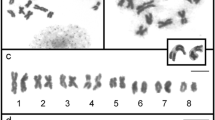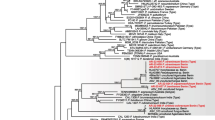Abstract
Parthenogenic Fasciola forms as well as bisexual Fasciola hepatica and Fasciola gigantica in mainland China have been identified on the basis of their spermatogenesis and genotypes in nuclear ribosomal internal transcribed spacer 1 (ITS1) and mitochondrial NADH dehydrogenase I (NDI). The Chinese aspermic Fasciola would include forms originating in interspecific hybrids between F. hepatica and F. gigantica, since they showed the genotype of ITS1-Fh/Fg that had mixed sequences of the two Fasciola species or heterogeneous genotypes in ITS1 and NDI. Additionally, there were Chinese aspermic flukes in which the sequences of ITS1 and NDI genotypes completely coincided with those in aspermic forms from Japan, Korea, and Vietnam, suggesting that the aspermic forms from these four countries are offspring with a common provenance. The Fh-C4 haplotype in NDI was detected in both aspermic specimens and F. hepatica, indicating that aspermic forms showing the haplotype might come into existence in China. The ratio of body length and width in aspermic Fasciola specimens showed intermediate values between those of F. hepatica and F. gigantica.

Similar content being viewed by others
References
Adlard RD, Barker SC, Blair D, Cribb TH (1993) Comparison of the second internal transcribed spacer (ribosomal DNA) from populations and species of Fasciolidae (Digenea). Int J Parasitol 23:423–425
Agatsuma T, Arakawa Y, Iwagami M, Honzako Y, Cahyaningsih U, Kang S-Y, Hong S-J (2000) Molecular evidence of natural hybridization between Fasciola hepatica and F. gigantica. Parasitol Int 49:231–238
Ashrafi K, Valero MA, Panova M, Periago MV, Massoud J, Mas-Coma S (2006) Phenotypic analysis of adults of Fasciola hepatica, Fasciola gigantica and intermediate forms from the endemic region of Gilan, Iran. Parasitol Int 55:249–260
Cai X, Chen H, Lei C, Wang S, Xue K, Zhang B (2007) mtDNA diversity and genetic lineages of eighteen cattle breeds from Bos taurus and Bos indicus in China. Genetica 131:175–183
Chu JK, Kim YK (1967) Taxonomical study on the Fasciolidae in Korea. Kor J Parasitol 5:139–146
Huang WY, He B, Wang CR, Zhu XQ (2004) Characterisation of Fasciola species from Mainland China by ITS-2 ribosomal DNA sequence. Vet Parasitol 120:75–83
Itagaki H, Akane S (1959) Morphological study on the Japanese liver fluke, compared with the African specimens. Bull Azabu Vet Coll 6:115–123
Itagaki T, Tsutsumi K (1998) Triploid form of Fasciola in Japan: genetic relationships between Fasciola hepatica and Fasciola gigantica determined by ITS-2 sequence of nuclear rDNA. Int J Parasitol 28:777–781
Itagaki T, Kikawa M, Sakaguchi K, Shimo J, Terasaki K, Shibahara T, Fukuda K (2005a) Genetic characterization of parthenogenic Fasciola sp. in Japan on the basis of the sequences of ribosomal and mitochondrial DNA. Parasitology 131:679–685
Itagaki T, Kikawa M, Terasaki K, Shibahara T, Fukuda K (2005b) Molecular characterization of parthenogenic Fasciola sp. in Korea on the basis of DNA sequences of ribosomal ITS1 and mitochondrial NDI gene. J Vet Med Sci 67:1115–1118
Itagaki T, Sakaguchi K, Terasaki K, Sasaki O, Yoshihara S, Van Dung T (2009) Occurrence of spermic diploid and aspermic triploid forms of Fasciola in Vietnam and their molecular characterization based on nuclear and mitochondrial DNA. Parasitol Int 58:81–85
Kimura S, Shimizu A, Kawano J (1984) Morphological observation on liver fluke detected from naturally infected carabaos in the Philippines. Sci Rept Fac Agr Kobe Univ 16:353–357
Lin RQ, Dong SJ, Nie K, Wang CR, Song HQ, Li AX, Huang WY, Zhu XQ (2007) Sequence analysis of the first internal transcribed spacer of rDNA supports the existence of the intermediate Fasciola between F. hepatica and F. gigantica in mainland China. Parasitol Res 101:813–817
Marcilla A, Bargues MD, Mas-Coma S (2002) A PCR-RFLP assay for the distinction between Fasciola hepatica and Fasciola gigantica. Mol Cell Probes 16:327–333
Moriyama N, Tsuji M, Seto T (1979) Three karyotypes and their phenotypes of Japanese liver flukes (Fasciola sp.). Jpn J Parasitol 28:23–33 in Japanese with English summary
Oshima T, Akahane H, Shimazu T (1968) Patterns of the variation of the common liver fluke (Fasciola sp.) in Japan. I. Variations in the sizes and shapes of the worms and eggs. Jpn J Parasitol 17:97–105 in Japanese with English summary
Periago MV, Valero MA, El Sayed M, Ashrafi K, El Wakeel A, Mohamed MY, Desquesnes M, Curtale F, Mas-Coma S (2007) First phenotypic description of Fasciola hepatica/Fasciola gigantica intermediate forms from the human endemic area of the Nile Delta, Egypt. Infect Genet Evol 8:51–58
Reddy PV, Subramanyam S (1973) Chromosome studies in the liver fluke, Fasciola gigantica Cobbold, 1856, from Andra Pradesh. Curr Sci 42:288–291
Sakaguchi Y (1980) Karyotype and gametogenesis of the common liver fluke, Fasciola sp., in Japan. Jpn J Parasitol 29:507–513
Sanderson AR (1953) Maturation and probable gynogenesis in the liver fluke, Fasciola hepatica L. Nature 172:110–112
Semyenova SK, Morozova EV, Chrisanfova GG, Gorokhov VV, Arkhipov IA, Moskvin AS, Movsessyan SO, Ryskov AP (2006) Genetic differentiation in eastern European and western Asian populations of the liver fluke, Fasciola hepatica, as revealed by mitochondrial nad1 and cox1 genes. J Parasitol 92:525–530
Swofford D L (2001) PAUP*. Phylogenetic analysis using parsimony and other methods ver. 4.0beta. Sinauer Associates, Sunderland, Massachussetts
Terasaki K, Akahane H, Habe S (1982) The geographical distribution of common liver flukes (the Genus Fasciola) with normal and abnormal spermatogenesis. Jpn J Vet Sci 44:223–231
Terasaki K, Moriyama-Gonda N, Noda Y (1998) Abnormal spermatogenesis in the common liver fluke (Fasciola sp.) from Japan and Korea. J Vet Med Sci 60:1305–1309
Thompson JD, Gibson TJ, Plewniak F, Jeanmougin F, Higgins DG (1997) The Clustal X windows interface: flexible strategies for multiple sequence alignment aided by quality analysis tools. Nucleic Acid Res 24:4876–4882
Torgerson P, Claxton J (1999) Epidemiology and control. In: Dalton JP (ed) Fasciolosis. CABI Publishing, UK, pp 113–149
Varma AK (1953) On Fasciola indica n. sp. with some observations on F. hepatica and F. gigantica. J Helminthol 27:185–198
Watanabe S (1958) General review on Fascioliasis hepatica in Japan. J Jpn Vet Med Assoc 11:293–299 (in Japanese)
Watanabe S, Iwata S (1954) Fasciola species in Japan. J Jpn Vet Med Assoc 7:124–126 (in Japanese)
Yin HZ, Ye BY (1990) Study on the karyotypes of Fasciola spp. Chin J Parasitol 8:124–126
Acknowledgments
This study was supported in part by a Grant-in-Aid for Scientific Research (B) (no. 18405035) from the Ministry of Education, Culture, Sports, Science and Technology of Japan.
Author information
Authors and Affiliations
Corresponding author
Rights and permissions
About this article
Cite this article
Peng, M., Ichinomiya, M., Ohtori, M. et al. Molecular characterization of Fasciola hepatica, Fasciola gigantica, and aspermic Fasciola sp. in China based on nuclear and mitochondrial DNA. Parasitol Res 105, 809–815 (2009). https://doi.org/10.1007/s00436-009-1459-0
Received:
Accepted:
Published:
Issue Date:
DOI: https://doi.org/10.1007/s00436-009-1459-0




